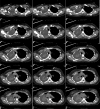Pseudochylothorax and diaphragmatic weakness secondary to a misplaced central venous catheter
- PMID: 23605827
- PMCID: PMC3645626
- DOI: 10.1136/bcr-2013-008765
Pseudochylothorax and diaphragmatic weakness secondary to a misplaced central venous catheter
Abstract
A 20-year-old woman admitted with an aspirin overdose was encephalopathic and was intubated for airway protection. Under sonographic guidance, a right internal jugular central venous catheter was inserted for volume resuscitation. She was agitated and required treatment with a propofol infusion. Her salicylate levels improved and she was successfully extubated 12 h after intubation. One day later she developed severe dyspnoea and a right-sided pleural effusion and required immediate reintubation. The effusion was drained and was consistent with a chylothorax. A CT scan of the chest revealed that the central venous catheter traversed the mediastinum with its tip in the right pleural space. The propofol infusion was draining into the pleural space. A video-assisted thoracoscopic surgery was performed to drain the pleural effusion and repair the punctured vessel. She was extubated within a day and discharged home 1 day later without any pleural fluid.
Figures
References
-
- Tocino IM, Watanabe A. Impending catheter perforation of superior vena cava—radiographic recognition. Am J Roentgenol 1986;2013:487–90 - PubMed
-
- Florescu MC, Moussa H, Salifu M, et al. Accidental extravascular insertion of a subclavian hemodialysis catheter is signaled by non-visualization of catheter tip. Hemodial Int 2005;2013:341–3 - PubMed
-
- Shiloni E, Meretyk S, Weiss J. Tension haemothorax: an unusual complication of central venous catheterization. Injury 1985;2013:385–6 - PubMed
-
- Apps MCP, Clark JMF, Skeater SJ. Hydrothorax, a complication of the insertion of central venous cannulae. Intens Care Med 1977;2013:41–3 - PubMed
Publication types
MeSH terms
Substances
LinkOut - more resources
Full Text Sources
Other Literature Sources



